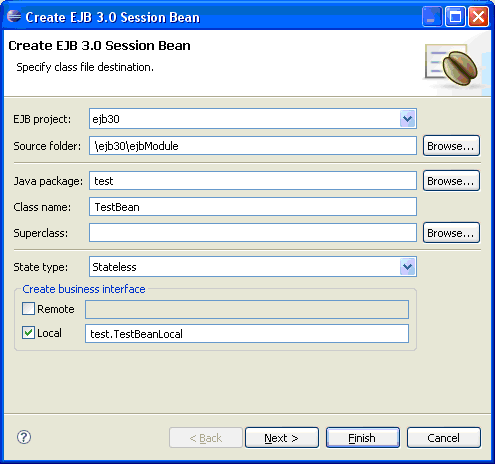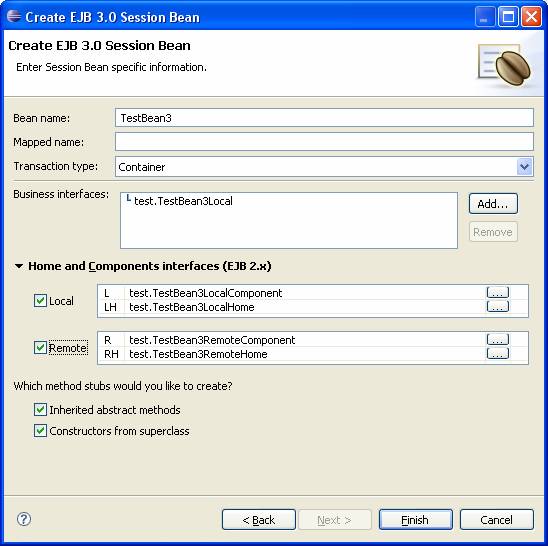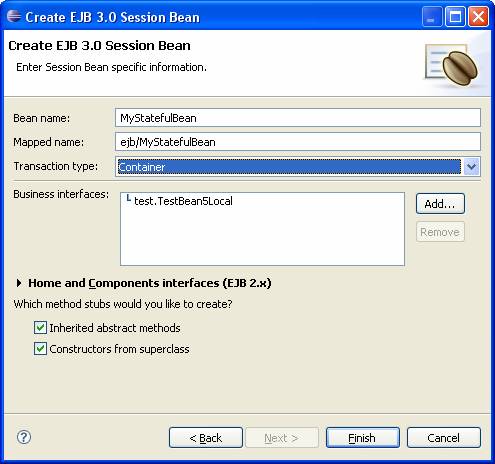Notice: this Wiki will be going read only early in 2024 and edits will no longer be possible. Please see: https://gitlab.eclipse.org/eclipsefdn/helpdesk/-/wikis/Wiki-shutdown-plan for the plan.
Difference between revisions of "EJB Test Plan/Session Bean Wizard"
(→Create Session Bean with Home and Components interfaces (EJB 2.x)) |
(→Create Stateful Session Bean) |
||
| (8 intermediate revisions by the same user not shown) | |||
| Line 11: | Line 11: | ||
# Create One EJB Project 3.0 and add it to the EAR. | # Create One EJB Project 3.0 and add it to the EAR. | ||
# Create a new Session Bean: | # Create a new Session Bean: | ||
| − | |||
#* enter "test" for Java package. | #* enter "test" for Java package. | ||
| − | |||
#* enter "TestBean" for Class name. | #* enter "TestBean" for Class name. | ||
#* State type must be Stateless by default. | #* State type must be Stateless by default. | ||
#* Check whether only "Create Business Interface > Local" is checked by default and leave it checked. | #* Check whether only "Create Business Interface > Local" is checked by default and leave it checked. | ||
#* [[Image:Session_bean_01.png]] | #* [[Image:Session_bean_01.png]] | ||
| − | |||
| − | |||
| − | |||
#* press Finish. | #* press Finish. | ||
| + | #Check that Session Bean class and interface exist in the project file structure. | ||
| + | #Verify that there is a node for the Deployment Descriptor and node for the Beans under the "Session Beans" node. | ||
| + | #Check that under this node all bean classes and interfaces are listed. | ||
| + | #Check if in the ‘ejbModule’ source folder there is the following annotation and the default constructor: | ||
| + | |||
| + | package test; | ||
| + | import javax.ejb.Stateless; | ||
| + | /** | ||
| + | * Session Bean implementation class TestBean | ||
| + | */ | ||
| + | @Stateless | ||
| + | public class TestBean implements TestBeanLocal { | ||
| + | /** | ||
| + | * Default constructor. | ||
| + | */ | ||
| + | public TestBean() { | ||
| + | // TODO Auto-generated constructor stub | ||
| + | } | ||
| + | } | ||
| + | |||
| + | |||
| + | |||
| + | == Create Remote Session Bean == | ||
| + | |||
#Create a new Stateless Session Bean: | #Create a new Stateless Session Bean: | ||
#*enter "test" for Java package. | #*enter "test" for Java package. | ||
| − | #*enter " | + | #*enter "TestBean1" for Class name. |
| − | + | ||
#*Check up Remote interface and uncheck Local interface. | #*Check up Remote interface and uncheck Local interface. | ||
| + | #*Next | ||
| + | #*Delete the name TestBean4 from the field Bean name. Error message is shown and Next and Finish buttons are disabled. | ||
| + | #*Enter some String that starts with a number, or has some symbols (except _ ). There should be an error and Next and Finish buttons are disabled. | ||
| + | #*Set Bean name: MyBean. | ||
| + | #*Set Mapped name: ejb/MyBean. | ||
#*Check whether in Business Interfaces section only TestBean1Remote interface is shown. | #*Check whether in Business Interfaces section only TestBean1Remote interface is shown. | ||
#*press Finish. | #*press Finish. | ||
| + | #Check if in the ‘ejbModule’ source folder the following code is generated: | ||
| + | |||
| + | package test; | ||
| + | import javax.ejb.Stateless; | ||
| + | /** | ||
| + | * Session Bean implementation class TestBean1 | ||
| + | */ | ||
| + | @Stateless(name = "MyBean", mappedName = "ejb/MyBean") | ||
| + | public class TestBean1 implements TestBean1Remote { | ||
| + | /** | ||
| + | * Default constructor. | ||
| + | */ | ||
| + | public TestBean1() { | ||
| + | // TODO Auto-generated constructor stub | ||
| + | } | ||
| + | } | ||
| + | |||
| + | == Create Session Bean with Remote and Local Interfaces == | ||
| + | |||
#Create a new Stateless Session Bean : | #Create a new Stateless Session Bean : | ||
#*enter "test" for Java package. | #*enter "test" for Java package. | ||
| Line 36: | Line 78: | ||
#*[[Image:Session_bean_02.png]] | #*[[Image:Session_bean_02.png]] | ||
#*press Finish. | #*press Finish. | ||
| − | #Check | + | #Check if in the ‘ejbModule’ source folder the following code is generated: |
| − | + | ||
| − | + | package test; | |
| + | import javax.ejb.Stateless; | ||
| + | /** | ||
| + | * Session Bean implementation class TestBean1_2 | ||
| + | */ | ||
| + | @Stateless | ||
| + | public class TestBean1_2 implements TestBean1_2Remote, TestBean1_2Local { | ||
| + | /** | ||
| + | * Default constructor. | ||
| + | */ | ||
| + | public TestBean1_2() { | ||
| + | // TODO Auto-generated constructor stub | ||
| + | } | ||
| + | } | ||
<< add more steps >> | << add more steps >> | ||
| + | |||
| + | == Validate fields of Session Bean wizard == | ||
| + | |||
| + | # Create a new Session Bean: | ||
| + | #* for Java package enter some String that starts with a number, or has some symbols (except _ ). There should be an error: Invalid Java package name… | ||
| + | #*Enter "test". | ||
| + | #*for Class name enter some String that starts with a number, or has some symbols (except _ ). There should be an error: Invalid Java class name. Next and Finish buttons are disabled. | ||
| + | #*enter "TestBean" for Class name. Check that there is an error: The class already exists in the package. | ||
| + | #*Enter some valid name. | ||
| + | #*Check up Remote and Local interfaces. | ||
| + | #*Delete the names in the fields. Error message is shown and Next and Finish buttons are disabled. | ||
| + | #*Set the same names in the Remote and Local Interfaces fields: | ||
| + | #*[[Image:Session_bean_07.png]] | ||
| + | #*go to next page | ||
| + | #*Delete the name TestBean4 from the field Bean name. Error message is shown and Next and Finish buttons are disabled. | ||
| + | #*Enter some String that starts with a number, or has some symbols (except _ ). There should be an error and Next and Finish buttons are disabled. | ||
| + | #*Set Bean name: MyBean. There should be an error: Enterprise bean with the same Ejb Name already exists. | ||
| + | #*[[Image:Session_bean_09.png]] | ||
| + | #*Set Mapped name: ejb/MyBean. | ||
== Create Session Bean with addition Business Interfaces == | == Create Session Bean with addition Business Interfaces == | ||
| Line 67: | Line 141: | ||
== Create Session Bean with Home and Components interfaces (EJB 2.x) == | == Create Session Bean with Home and Components interfaces (EJB 2.x) == | ||
| + | |||
#Create a new Stateless Session Bean : | #Create a new Stateless Session Bean : | ||
#*enter "test" for Java package | #*enter "test" for Java package | ||
| Line 74: | Line 149: | ||
#*Check Local and Remote | #*Check Local and Remote | ||
#*Leave the Inherited abstract methods and Constructors from superclass checkboxes checked. | #*Leave the Inherited abstract methods and Constructors from superclass checkboxes checked. | ||
| − | #*[[Image: | + | #*[[Image:Session_bean_04.png]] |
#*Press Finish | #*Press Finish | ||
#Check if in the ‘ejbModule’ source folder there are the following annotations: | #Check if in the ‘ejbModule’ source folder there are the following annotations: | ||
| Line 81: | Line 156: | ||
@LocalHome(TestBean3LocalHome.class) | @LocalHome(TestBean3LocalHome.class) | ||
@RemoteHome(TestBean3RemoteHome.class) | @RemoteHome(TestBean3RemoteHome.class) | ||
| + | |||
| + | |||
| + | << add more steps >> | ||
| + | |||
| + | |||
| + | |||
| + | == Create Session Bean with Transaction Type Bean == | ||
| + | |||
| + | #Create a new Stateless Session Bean : | ||
| + | #*enter "test" for Java package | ||
| + | #*enter "TestBean4" for Class name | ||
| + | #*go to next page | ||
| + | #*Select for Transaction Type : Bean. | ||
| + | #*Leave the Inherited abstract methods and Constructors from superclass check boxes checked. | ||
| + | #*Press Finish. | ||
| + | #Check if in the ‘ejbModule’ source folder there are the following annotations: | ||
| + | |||
| + | @Stateless | ||
| + | @TransactionManagement(TransactionManagementType.BEAN) | ||
| + | |||
| + | |||
| + | |||
| + | == Create Stateful Session Bean == | ||
| + | |||
| + | #Create a new Session Bean : | ||
| + | #*enter "test" for Java package. | ||
| + | #*enter "TestBean5" for Class name. | ||
| + | #*Set for State Type: Stateful. | ||
| + | #*go to next page. | ||
| + | #*Set the Bean name: MyStatefulBean. | ||
| + | #*Set Mapped name: ejb/MyStatefulBean. | ||
| + | #*Leave the Inherited abstract methods and Constructors from superclass checkboxes checked. | ||
| + | #*[[Image:Session_bean_06.png]] | ||
| + | #*Press Finish. | ||
| + | #Check if in the ‘ejbModule’ source folder there are the following annotations: | ||
| + | |||
| + | @Stateful(name = "MyStatefulBean", mappedName = "ejb/MyStatefulBean") | ||
Latest revision as of 03:05, 4 July 2008
Functional tests for the Session Bean wizard.
Contents
- 1 Prerequisites
- 2 Create Default Session Bean
- 3 Create Remote Session Bean
- 4 Create Session Bean with Remote and Local Interfaces
- 5 Validate fields of Session Bean wizard
- 6 Create Session Bean with addition Business Interfaces
- 7 Create Session Bean with Home and Components interfaces (EJB 2.x)
- 8 Create Session Bean with Transaction Type Bean
- 9 Create Stateful Session Bean
Prerequisites
- Java EE 5 compatible runtime installed: JBoss, Glassfish, etc.
- an EAR 5 project created.
Create Default Session Bean
- Open the Java EE perspective.
- Create One EJB Project 3.0 and add it to the EAR.
- Create a new Session Bean:
- Check that Session Bean class and interface exist in the project file structure.
- Verify that there is a node for the Deployment Descriptor and node for the Beans under the "Session Beans" node.
- Check that under this node all bean classes and interfaces are listed.
- Check if in the ‘ejbModule’ source folder there is the following annotation and the default constructor:
package test;
import javax.ejb.Stateless;
/**
* Session Bean implementation class TestBean
*/
@Stateless
public class TestBean implements TestBeanLocal {
/**
* Default constructor.
*/
public TestBean() {
// TODO Auto-generated constructor stub
}
}
Create Remote Session Bean
- Create a new Stateless Session Bean:
- enter "test" for Java package.
- enter "TestBean1" for Class name.
- Check up Remote interface and uncheck Local interface.
- Next
- Delete the name TestBean4 from the field Bean name. Error message is shown and Next and Finish buttons are disabled.
- Enter some String that starts with a number, or has some symbols (except _ ). There should be an error and Next and Finish buttons are disabled.
- Set Bean name: MyBean.
- Set Mapped name: ejb/MyBean.
- Check whether in Business Interfaces section only TestBean1Remote interface is shown.
- press Finish.
- Check if in the ‘ejbModule’ source folder the following code is generated:
package test;
import javax.ejb.Stateless;
/**
* Session Bean implementation class TestBean1
*/
@Stateless(name = "MyBean", mappedName = "ejb/MyBean")
public class TestBean1 implements TestBean1Remote {
/**
* Default constructor.
*/
public TestBean1() {
// TODO Auto-generated constructor stub
}
}
Create Session Bean with Remote and Local Interfaces
- Create a new Stateless Session Bean :
- Check if in the ‘ejbModule’ source folder the following code is generated:
package test;
import javax.ejb.Stateless;
/**
* Session Bean implementation class TestBean1_2
*/
@Stateless
public class TestBean1_2 implements TestBean1_2Remote, TestBean1_2Local {
/**
* Default constructor.
*/
public TestBean1_2() {
// TODO Auto-generated constructor stub
}
}
<< add more steps >>
Validate fields of Session Bean wizard
- Create a new Session Bean:
- for Java package enter some String that starts with a number, or has some symbols (except _ ). There should be an error: Invalid Java package name…
- Enter "test".
- for Class name enter some String that starts with a number, or has some symbols (except _ ). There should be an error: Invalid Java class name. Next and Finish buttons are disabled.
- enter "TestBean" for Class name. Check that there is an error: The class already exists in the package.
- Enter some valid name.
- Check up Remote and Local interfaces.
- Delete the names in the fields. Error message is shown and Next and Finish buttons are disabled.
- Set the same names in the Remote and Local Interfaces fields:
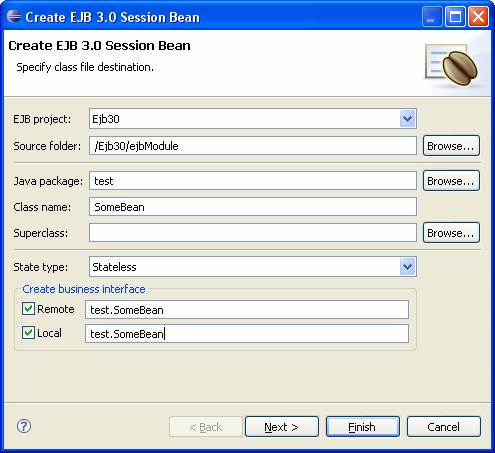
- go to next page
- Delete the name TestBean4 from the field Bean name. Error message is shown and Next and Finish buttons are disabled.
- Enter some String that starts with a number, or has some symbols (except _ ). There should be an error and Next and Finish buttons are disabled.
- Set Bean name: MyBean. There should be an error: Enterprise bean with the same Ejb Name already exists.
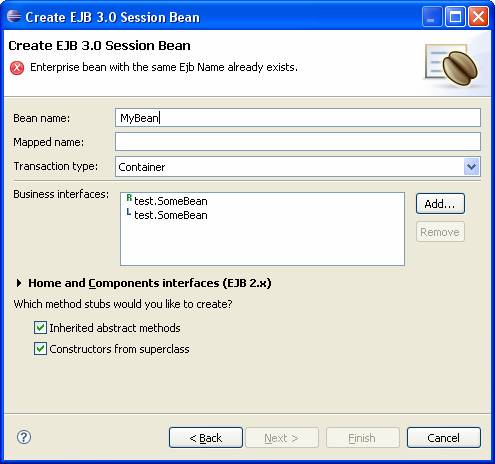
- Set Mapped name: ejb/MyBean.
Create Session Bean with addition Business Interfaces
- Create a new Stateless Session Bean :
- enter "test" for Java package.
- enter "TestBean2" for Class name.
- go to next page.
- add new Business Interfaces.
- Select one Interface and check the radio button Local, press OK.
- Select the new interface from the Business Interface and press Remove button.
- Press Back, and then Next again and check that this interface is not listed.
- add new Business Interfaces as Local.
- Leave the Inherited abstract methods and Constructors from superclass check boxes checked.

- Press Finish.
- Check if in the ejbModule source folder class TestBean2 implements the interfaces:TestBean2Local and the added interface.
- Create a new Stateless Session Bean :
- enter "test" for Java package.
- enter "TestBean2_1" for Class name.
- go to next page.
- add new Business Interfaces as Remote.
- Leave the Inherited abstract methods and Constructors from superclass check boxes checked.
- Check if in the ‘ejbModule’ source folder class TestBean2_1 implements the interfaces:TestBean2_1Local and the added interface.
- Check that inherited methods and constructors are created.
<< add more steps >>
Create Session Bean with Home and Components interfaces (EJB 2.x)
- Create a new Stateless Session Bean :
- Check if in the ‘ejbModule’ source folder there are the following annotations:
@Stateless
@LocalHome(TestBean3LocalHome.class)
@RemoteHome(TestBean3RemoteHome.class)
<< add more steps >>
Create Session Bean with Transaction Type Bean
- Create a new Stateless Session Bean :
- enter "test" for Java package
- enter "TestBean4" for Class name
- go to next page
- Select for Transaction Type : Bean.
- Leave the Inherited abstract methods and Constructors from superclass check boxes checked.
- Press Finish.
- Check if in the ‘ejbModule’ source folder there are the following annotations:
@Stateless
@TransactionManagement(TransactionManagementType.BEAN)
Create Stateful Session Bean
- Create a new Session Bean :
- Check if in the ‘ejbModule’ source folder there are the following annotations:
@Stateful(name = "MyStatefulBean", mappedName = "ejb/MyStatefulBean")

